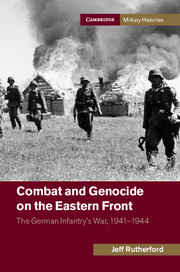Book contents
- Frontmatter
- Table of contents
- List of illustrations
- List of figures
- List of maps
- List of tables
- Acknowledgments
- Introduction
- 1 The Wehrmacht and German society
- 2 Preparations for war
- 3 “Attack with a ruthless offensive spirit and … a firestorm of destruction”
- 4 “Will the continuation of this attackbe worth it?”
- 5 “It is only a question of where, not if, civilians will starve”
- 6 The failure of Operation Barbarossa
- 7 The Soviet winter offensive, 1942
- 8 “The population … shouted out to the interpreter that one would rather be shot instead of being left to starve”
- 9 “From one mess to another”
- 10 “We need to fight to the end, so oder so”
- 11 A more rational occupation?
- 12 “As miserable representatives of themiserable twentieth century, we burnedall of the villages”
- Conclusion
- Bibliography
- Index
- References
11 - A more rational occupation?
The contradictions of military necessity
Published online by Cambridge University Press: 05 July 2014
- Frontmatter
- Table of contents
- List of illustrations
- List of figures
- List of maps
- List of tables
- Acknowledgments
- Introduction
- 1 The Wehrmacht and German society
- 2 Preparations for war
- 3 “Attack with a ruthless offensive spirit and … a firestorm of destruction”
- 4 “Will the continuation of this attackbe worth it?”
- 5 “It is only a question of where, not if, civilians will starve”
- 6 The failure of Operation Barbarossa
- 7 The Soviet winter offensive, 1942
- 8 “The population … shouted out to the interpreter that one would rather be shot instead of being left to starve”
- 9 “From one mess to another”
- 10 “We need to fight to the end, so oder so”
- 11 A more rational occupation?
- 12 “As miserable representatives of themiserable twentieth century, we burnedall of the villages”
- Conclusion
- Bibliography
- Index
- References
Summary
Two days before the 123rd ID completed its withdrawal from the Demiansk position behind the Lovat river, Army Group North issued twenty-five pages of occupation guidelines for its area of operations. This major policy initiative proves noteworthy in two ways. First, while the directive attempted to lay the foundation for a more conciliatory occupation policy, the fact that it was issued before elements of Sixteenth Army had finished with their destruction of the Demiansk position suggests that the rampant contradictions within German military policy remained irreconcilable. Second, the simple notion that the command felt the need to issue such a directive during the third year of war highlights the relative confusion that plagued German military occupation authorities in the Soviet Union. The conflicts inherent in their competing versions of military necessity ensured that this occupation policy would prove no more successful than previous ones in harnessing the civilian population to the German war effort.
Army Group North stated that it had the “task of re-establishing and maintaining public life and public order in the area, as this served the interests of the German Wehrmacht.” The division of labor between the army, SS-Police forces, and the Economic Staff East received further confirmation as the Wehrmacht was “not responsible” for economic matters or propaganda; it nonetheless “worked closely together” with Economic Staff East and the higher SS and police leader (HSSPF) for northwest Russia.
- Type
- Chapter
- Information
- Combat and Genocide on the Eastern FrontThe German Infantry's War, 1941–1944, pp. 330 - 356Publisher: Cambridge University PressPrint publication year: 2014



